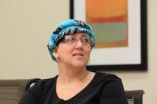(Press-News.org) GRAND RAPIDS, Mich., June 11, 2013 – Spectrum Health is the first health system in Michigan and among the first in the nation to successfully implant a recently FDA-approved device that uses electric stimulation of the brain to treat adult epilepsy patients whose seizures have not responded to medication.
The NeuroPace® Responsive Neurostimulation (RNS®) System is an implantable therapeutic device designed to detect abnormal electrical activity in the brain and respond by delivering imperceptible electrical stimulation to normalize brain activity before an individual experiences seizures.
The procedure was successfully carried out May 6 in a six-hour surgery at Spectrum Health Butterworth Hospital in Grand Rapids. The first patient, Amy Owen, 44, of Marshall, Mich., is recovering at home. A second patient, Kelly Cromer, 43, of Dowagiac, Mich., underwent surgery May 14 and also is recovering at home. (Links to surgery and interview footage of Kelly Cromer).
The operations were carried out by a team led by Kost Elisevich, MD, PhD, neurosurgeon, co-chair department of clinical neurosciences, chief, division of neurosurgery, Spectrum Health Medical Group. Dr. Elisevich was assisted in the May 6 surgery by neurosurgeon Sanjay Patra, MD, and in the May 14 procedure by neurosurgeon Artur Szymczak, MD.
The surgery places the NeuroPace RNS Neurostimulator, essentially a battery powered microprocessor, into a cavity created in the patient's cranium. This device is connected to electrodes implanted in the brain at the site where seizures are believed to originate. The May 6 procedure was the first of its kind in the state of Michigan and was among the first 20 such procedures in the nation. Spectrum Health is one of only 10 Level 4 epilepsy centers currently approved to conduct the surgery.
"Spectrum Health's neuroscience program continues to expand its clinical and surgical offerings, providing patients highly specialized care in their region and exceeding important national quality standards," said Kevin Splaine, president, Spectrum Health Hospitals, Grand Rapids. "Our epilepsy team is specially designated for its superior medical and surgical care."
Owen was admitted to the Epilepsy Monitoring Unit at Spectrum Health Butterworth Hospital in late April. In an initial procedure, Dr. Elisevich surgically implanted electrodes into her brain to initiate the monitoring of seizures with a continuous inpatient video electroencephalographic (vEEG).
This mapping pinpointed the origin of Owen's seizures in the left temporal lobe, enabling physicians to target the optimal location for placement of the NeuroPace RNS Neurostimulator, a titanium microprocessor measuring about one by two inches, which is connected to electrodes implanted at the site of seizure origin. The monitoring also indicated that Owen was undergoing near continuous seizure activity while she slept.
While her doctors consider the operation to be a success, they caution that the work of monitoring and interrupting seizure activity in Owen's brain is only just beginning.
"Seizure activity can often be temporarily disrupted by the placing of electrodes during surgery," Dr. Elisevich said. "The next phase is to wait for her brain to start misbehaving again so that the computer can be programmed to interrupt the dysfunctional signaling."
During this phase of the process, the patient uses an electronic wand to download data from the device on a daily basis. This information enables her medical team to track her seizure activity and disrupt it by programming the device to deliver short, imperceptible electrical pulses to the brain through the implanted electrodes.
"This information will enable us to identify a distinct pattern of seizure onset, which we can break down by frequency, amplitude and a number of other factors," said Owen's neurologist, Brien Smith, MD, co-chair, department of clinical neurosciences, chief, division of neurology, Spectrum Health Medical Group. "This makes us very optimistic that we can alter abnormal brain activity and significantly reduce seizure initiation and spread."
The RNS System is designed for use in combination with other therapies in reducing the frequency of seizures in individuals 18 years of age or older. It is indicated for use in patients with partial onset seizures – seizures that originate and remain in a limited area of the brain. To be eligible for the procedure, patients must have frequent and disabling seizures (motor partial seizures, complex partial seizures and/or secondarily generalized seizures), whose origin is limited to two or fewer locations in the brain.
The U.S. Food and Drug Administration (FDA) granted premarket approval for the RNS System on November 14, 2013. While employed at Henry Ford Health System, Drs. Elisevich and Smith were one of the first clinical teams in the nation to participate in clinical trials using the RNS System.
Epilepsy is the third most common neurological disorder in the United States after Alzheimer's disease and stroke, affecting 2.2 million Americans, according to the Centers for Disease Control and Prevention (CDC). Older adults are among the fastest-growing segments of the population for new cases of the disease.
Treatment with the RNS System is taking place in Level 4 epilepsy centers throughout the nation following site qualification and physician training. Spectrum Health is the first epilepsy program in West Michigan to receive a Level 4 designation by the National Association of Epilepsy Centers (NAEC). Level 4 centers have the professional expertise and facilities to provide the highest level of medical and surgical epilepsy evaluation and treatment for patients with epilepsy.
INFORMATION:
Spectrum Health is a not-for-profit health system, based in West Michigan, offering a full continuum of care through the Spectrum Health Hospital Group, which is comprised of 11 hospitals including Helen DeVos Children's Hospital; 170 ambulatory and service sites; 1,080 employed physicians and advanced practice providers including members of the Spectrum Health Medical Group; and Priority Health, a 575,000-member health plan. Spectrum Health is West Michigan's largest employer with 21,300 employees. The organization provided $250 million in community benefit during its 2013 fiscal year.
spectrumhealth.org
Spectrum Health among first to implant neurostimulator for epilepsy
2014-06-12
ELSE PRESS RELEASES FROM THIS DATE:
Peer influence leads teens to start, stop smoking -- but effect is stronger for starting
2014-06-11
WASHINGTON, DC, June 11, 2014 — Adolescents tend to be more powerful in influencing their friends to start smoking than in helping them to quit, according to sociologists.
In a study of adolescent friendship networks and smoking over time, the researchers found that friends exert influence on their peers to both start and quit smoking, but the influence to start is stronger.
"What we found is that social influence matters — it leads nonsmoking friends into smoking and nonsmoking friends can turn smoking friends into nonsmokers," said Steven Haas, an associate professor ...
Infant immune systems learn fast, but have short memories
2014-06-11
ITHACA, N.Y. – Forgetful immune systems leave infants particularly prone to infections, according to a new Cornell University study. Upending the common theory that weak immune cells are to blame, the study has found that infants' immune systems actually respond to infection with more speed and strength than adults, but the immunities they create fail to last.
Published in the Journal of Immunology, the discovery reveals a new angle immunizations could take in protecting infants and children from infectious diseases.
"The perfect vaccine would be a single dose given ...
Study confirms how the body regulates high levels of CO2 in the blood
2014-06-11
In a recently published study in the journal Experimental Physiology, Brazilian researchers have confirmed the importance of a specific group of neurons found in a region of the brain known as the retrotrapezoid nucleus (RTN) in detecting changes in carbon dioxide (CO2) levels and in modulating the activity of the neuronal groups that control respiratory activity.
Scientists from the Biomedical Sciences Institute of the University of São Paulo (USP) and the School of Dentistry at the São Paulo State University (Unesp) participated in the study.
"CO2 is important for regulating ...
Expert CLABSI guidance adds real world implementation strategies
2014-06-11
CHICAGO (June 1, 2014) – As central-line associated bloodstream infections (CLABSIs) pose a danger to vulnerable patients, infection prevention and control experts released new practical recommendations to assist acute care hospitals in implementing and prioritizing prevention efforts.
The guidance was published in the July issue of Infection Control and Hospital Epidemiology and produced in a collaborative effort led by the Society for Healthcare Epidemiology of America, the Infectious Diseases Society of America, the American Hospital Association, the Association for ...
Coordinated intervention reduced prevalence of drug-resistant CRE in long-term care
2014-06-11
CHICAGO (June 11, 2014) – A new study found a nationwide effort to control carbapenem-resistant Enterobacteriaceae (CRE) in Israel reduced CRE cases by improving compliance of infection control standards and using a coordinated intervention focused on long-term care facilities. The study was published in the July issue of Infection Control and Hospital Epidemiology, the journal of the Society for Healthcare Epidemiology of America.
"As the global threat of CRE continues to rise, there is a need to better control and understand this bacteria," said Debby Ben-David, MD, ...
EARTH Magazine: Dueling dinosaurs hit the auction block
2014-06-11
Alexandria, Va. — In 2006, a fossil collector and his crew discovered a rare fossil on private land in Montana's Hell Creek Formation: the bones of two fully articulated dinosaurs that appeared to have died together, locked in battle. The fossil duo — a small, pony-sized carnivorous tyrannosaurid and a slightly larger herbivorous ceratopsian, both now preserved in plaster — became known as the "Montana Dueling Dinosaurs." Last November, the fossils were put on the block at Bonhams auction house in New York City — but they did not sell. Had the set fetched the nearly $9 ...
Are Quebecers irrationally opposed to shale gas?
2014-06-11
Quebecers are particularly hostile toward the development of shale gas, but this aversion is driven less by 'not in my backyard' (NIMBY) attitudes than 'not in anyone's backyard (NIABY), according to a comparative study of 2,500 Quebecers and Americans conducted by Éric Montpetit and Erick Lachapelle of the University of Montreal's Department of Political Science. Professors Barry G. Rabe of the University of Michigan and Christopher P. Borick of Muhlenberg College co-led the study in the United States.
The study, commissioned by Quebec's Ministry of the Environment, ...
Findings may advance iron-rich, cadmium-free crops
2014-06-11
ITHACA, N.Y. – With news reports of toxic, cadmium-tainted rice in China, a new study describes a protein that transports metals in certain plants and holds promise for developing iron-rich but cadmium-free crops.
Iron and cadmium are both found in soil and are interchangeably taken up by iron transporters in plants. Pollution and heavy fertilizer use have increased soil cadmium levels in China, for example. In humans, cadmium can damage internal organs and cause cancer. At the same time, iron is an essential nutrient for plants and humans. Iron deficiency affects 30 ...
Manipulating and detecting ultrahigh frequency sound waves
2014-06-11
An advance has been achieved towards next generation ultrasonic imaging with potentially 1,000 times higher resolution than today's medical ultrasounds. Researchers with the U.S. Department of Energy (DOE)'s Lawrence Berkeley National Laboratory (Berkeley Lab) have demonstrated a technique for producing, detecting and controlling ultrahigh frequency sound waves at the nanometer scale.
Through a combination of subpicosecond laser pulses and unique nanostructures, a team led by Xiang Zhang, a faculty scientist with Berkeley Lab's Materials Sciences Division, produced acoustic ...
Famine fear won't sway minds on GM crops
2014-06-11
ITHACA, N.Y. – A sack-hauling time traveler from the 21st century lands in an Irish potato field in 1849, just before a terrible famine, and asks: If you thought genetically modified potatoes could avert late blight disease, spare a million countrymen from starvation and keep another million from emigrating off the Emerald Isle, would you plant these newfangled spuds?
Fast forward to the Internet Age, when communication researchers ran 859 U.S. grocery shoppers through a similar thought experiment: Half the subjects in an online survey read the story of the 1850s Irish ...




